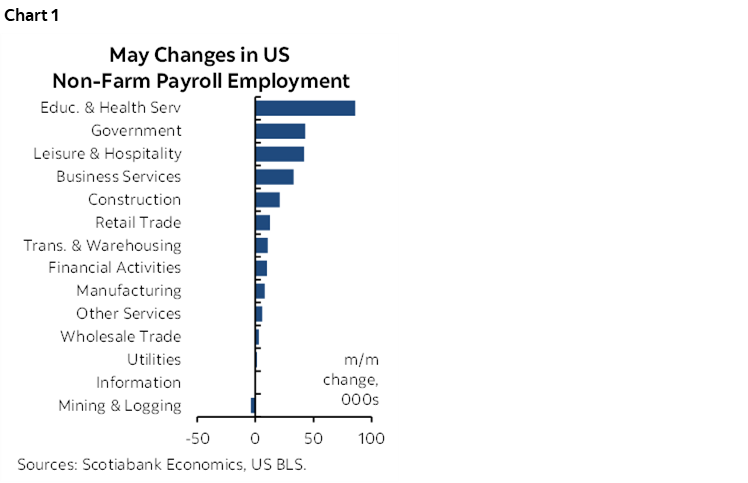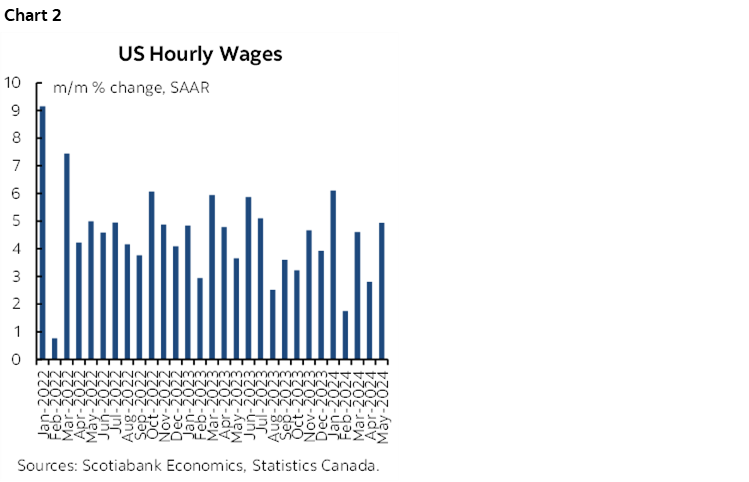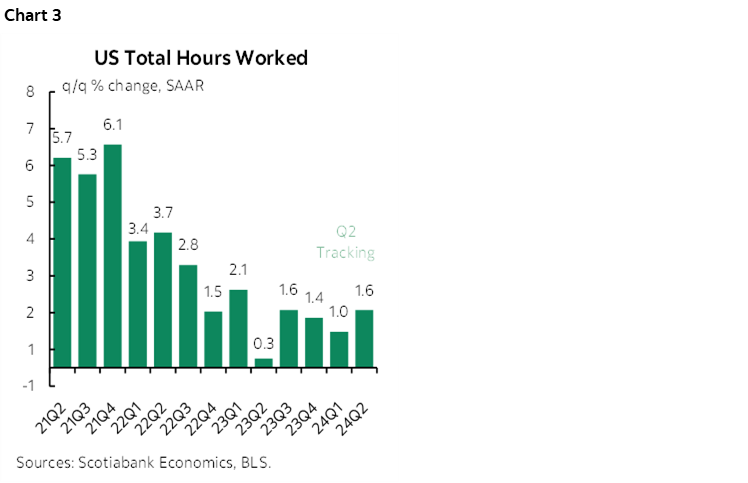- Payrolls expanded at a brisk pace
- Wage growth accelerated
- Hours worked point to moderate US GDP growth
- Markets are forgetting that the FOMC will remain more focused upon inflation than jobs
- US nonfarm payrolls m/m 000s // UR %, SA, May:
- Actual: 272 / 4.0
- Scotia: 205 / 3.9
- Consensus: 180 / 3.9
- Prior: 165 / 3.9 (revised from 175 / 3.9)
This was a strong overall jobs report. Markets responded by driving the US 2-year yield up by about 12bps and 10s up 13bps. The dollar gained. Fed funds futures are pricing between 25–50bps of cuts by year-end.
The gain of 272k payroll positions was in the direction of the Scotia Economics’ call for an above-consensus reading, but still within the bands of statistical noise given a +/-130k 90% confidence band around estimated changes in job growth.
Revisions to job growth were modest by only reducing the prior two months by 15k on net.
Sector breadth was high (chart 1)

Wage growth was firmer than expected at 0.4% m/m SA (consensus and Scotia 0.3%). That’s 4.9% m/m SAAR and the three month moving average is 4.1% m/m SAAR (chart 2).

Hours worked were up by 2.1% m/m SAAR. They are tracking a rise of 1.6% q/q SAAR in Q2 from 1% in Q1 (chart 3). That signals moderate GDP growth in Q2 given that GDP is an identity defined as hours times productivity.

The unemployment rate edged up to 4%. It is derived from the companion household survey that showed a loss of 408k jobs while the labour force expanded by 250k.
I'm sure the usual concerns will surface in pointing to the spread between US payrolls that were up 272k and the household survey's 408k drop in jobs. Some cautions include that the household survey is much 'noisier' in terms of confidence bands around the estimates; maybe that household survey will jump higher next month on the same noise argument. The household survey also captures off-payroll firms and hence particularly small businesses. Nonfarm payrolls include multiple job holders by counting payroll jobs whereas the household survey counts bodies.
I think the market reaction is overdone in terms of implications for the Federal Reserve. The GDP signals are compatible with expecting softening GDP growth and the FOMC is much more focused upon inflation than the full employment part of its mandate. Next week’s CPI print may matter more to them.
The FOMC is widely expected to leave policy unchanged next Wednesday. I would expect the consensus to lower the expected amount of rate cuts to –50bps this year while Chair Powell retains the same optimism that inflation will cool going forward. A September cut remains our base case for the first move this year.
DISCLAIMER
This report has been prepared by Scotiabank Economics as a resource for the clients of Scotiabank. Opinions, estimates and projections contained herein are our own as of the date hereof and are subject to change without notice. The information and opinions contained herein have been compiled or arrived at from sources believed reliable but no representation or warranty, express or implied, is made as to their accuracy or completeness. Neither Scotiabank nor any of its officers, directors, partners, employees or affiliates accepts any liability whatsoever for any direct or consequential loss arising from any use of this report or its contents.
These reports are provided to you for informational purposes only. This report is not, and is not constructed as, an offer to sell or solicitation of any offer to buy any financial instrument, nor shall this report be construed as an opinion as to whether you should enter into any swap or trading strategy involving a swap or any other transaction. The information contained in this report is not intended to be, and does not constitute, a recommendation of a swap or trading strategy involving a swap within the meaning of U.S. Commodity Futures Trading Commission Regulation 23.434 and Appendix A thereto. This material is not intended to be individually tailored to your needs or characteristics and should not be viewed as a “call to action” or suggestion that you enter into a swap or trading strategy involving a swap or any other transaction. Scotiabank may engage in transactions in a manner inconsistent with the views discussed this report and may have positions, or be in the process of acquiring or disposing of positions, referred to in this report.
Scotiabank, its affiliates and any of their respective officers, directors and employees may from time to time take positions in currencies, act as managers, co-managers or underwriters of a public offering or act as principals or agents, deal in, own or act as market makers or advisors, brokers or commercial and/or investment bankers in relation to securities or related derivatives. As a result of these actions, Scotiabank may receive remuneration. All Scotiabank products and services are subject to the terms of applicable agreements and local regulations. Officers, directors and employees of Scotiabank and its affiliates may serve as directors of corporations.
Any securities discussed in this report may not be suitable for all investors. Scotiabank recommends that investors independently evaluate any issuer and security discussed in this report, and consult with any advisors they deem necessary prior to making any investment.
This report and all information, opinions and conclusions contained in it are protected by copyright. This information may not be reproduced without the prior express written consent of Scotiabank.
™ Trademark of The Bank of Nova Scotia. Used under license, where applicable.
Scotiabank, together with “Global Banking and Markets”, is a marketing name for the global corporate and investment banking and capital markets businesses of The Bank of Nova Scotia and certain of its affiliates in the countries where they operate, including; Scotiabank Europe plc; Scotiabank (Ireland) Designated Activity Company; Scotiabank Inverlat S.A., Institución de Banca Múltiple, Grupo Financiero Scotiabank Inverlat, Scotia Inverlat Casa de Bolsa, S.A. de C.V., Grupo Financiero Scotiabank Inverlat, Scotia Inverlat Derivados S.A. de C.V. – all members of the Scotiabank group and authorized users of the Scotiabank mark. The Bank of Nova Scotia is incorporated in Canada with limited liability and is authorised and regulated by the Office of the Superintendent of Financial Institutions Canada. The Bank of Nova Scotia is authorized by the UK Prudential Regulation Authority and is subject to regulation by the UK Financial Conduct Authority and limited regulation by the UK Prudential Regulation Authority. Details about the extent of The Bank of Nova Scotia's regulation by the UK Prudential Regulation Authority are available from us on request. Scotiabank Europe plc is authorized by the UK Prudential Regulation Authority and regulated by the UK Financial Conduct Authority and the UK Prudential Regulation Authority.
Scotiabank Inverlat, S.A., Scotia Inverlat Casa de Bolsa, S.A. de C.V, Grupo Financiero Scotiabank Inverlat, and Scotia Inverlat Derivados, S.A. de C.V., are each authorized and regulated by the Mexican financial authorities.
Not all products and services are offered in all jurisdictions. Services described are available in jurisdictions where permitted by law.

